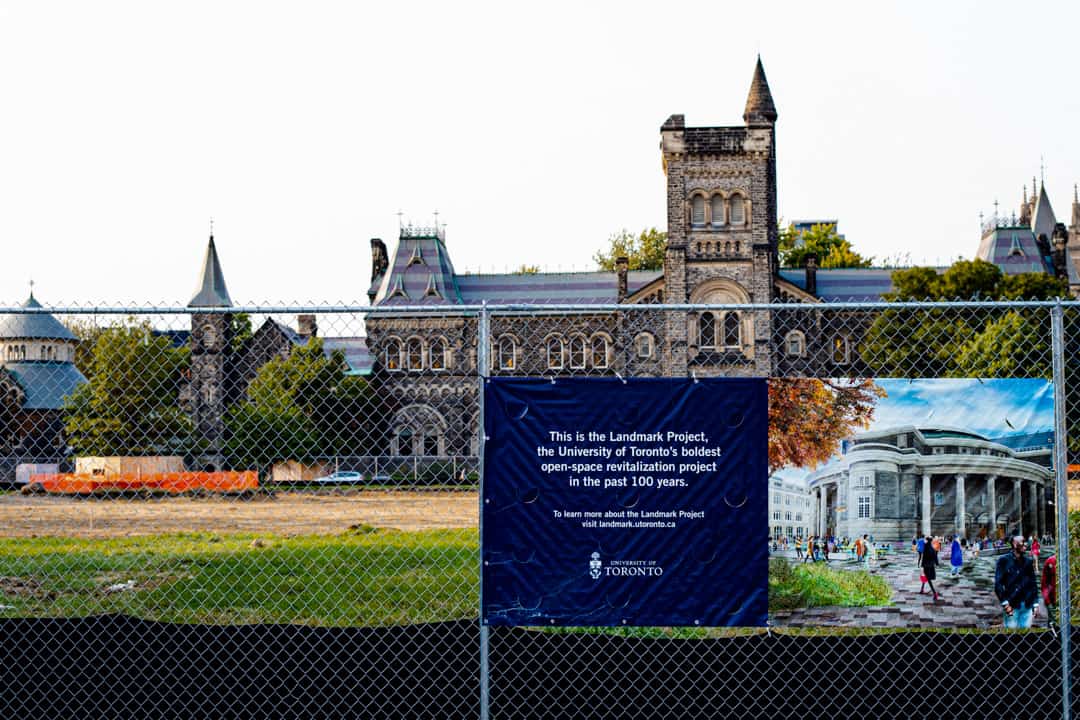In early May, U of T launched construction on its Landmark Project at King’s College Circle, marking the beginning of the three-year rejuvenation of the historic UTSG campus.
The construction will cover multiple areas around the historic core, including King’s College Circle, Hart House Circle, Sir Daniels Wilson Quad, and back campus. The project plans to move car lanes and parking underground in order to build a more pedestrian-friendly space at the UTSG campus.
The project will also feature a geothermal field, the largest one in any Canadian city. The geothermal field is projected to help U of T achieve its goal of reducing greenhouse gas emission by 37 per cent from 1990 levels by the year 2030.
Construction
This project aims to rebuild connection with heritage landscapes within the U of T community. According to U of T Vice-President Operations and Real Estate Partnerships Scott Mabury, the area has long been dominated by cars, both in terms of traffic and parking.
Public consultation started over a year ago before the project officially started. According to Mabury, the community discussed its expectations during multiple workshops and open houses. Although the project is located at UTSG, its cultural significance to the entire U of T community made it an institutional-wide decision through tri-campus consultations. The plan, according to Mabury, received a unanimously positive response.
The project received funding from over 3,000 donors, many more than most construction projects, said Mabury. Two of the biggest gifts were from the University of Toronto Students’ Union (UTSU) and the University of Toronto Alumni Association (UTAA). “[This] gives you a sense that this is really a special project,” he added.
UTSU donated $250,000, and UTAA donated $1,000,000.
Asked about U of T’s plan to control disruption when the campus population returns to normal after the pandemic, Mabury responded that this situation is why the project will take three years.
“We could have done it faster, but it would have been more disruptive,” said Mabury. He said that the construction timeline is a balance between minimizing disruption and completing within a reasonable time.
Environmental impacts
The project also includes a geo-exchange system, which, upon completion, will be the largest in urban Canada. The system can absorb heat when there is an excess and use it in cold weather instead of directly releasing it into the atmosphere.
With the geothermal field implemented, U of T expects to save 15,000 metric tonnes of carbon per year. This is part of the broader goal to be carbon-neutral by 2050, as per the Low Carbon Action Plan.
However, the construction process can still negatively affect the environment. Excavation for the geothermal boreholes and underground parking requires a removal of the front campus lawn completely, a disruption to the mini-ecosystem.
Urban engineering and ecology professor Susan Andrews, from the Department of Civil and Mineral Engineering, wrote to The Varsity in an email that protecting the mature trees is critical to make sure the ecological system can bounce back when construction is completed. In an effort to do so, “tree protection zones” have been put around trees across the construction site.
Still, Andrews believes that the project’s ultimate goal to reduce car-related impacts on the environment will eventually enhance the recovery of the front campus area’s natural ecology. “I think that the result will be a much more ecologically robust area,” wrote Andrews. “I would hope that the micro-ecological system associated with the lawn will be re-established relatively quickly upon project completion.”
Aesthetic values
Brian Melcher, the project’s co-designer and an associate from KPMB Architects, a Toronto-based architecture firm, said inclusiveness is behind the envisioning of the car-free zone. In his opinion, giving the entire landscape back to pedestrians and cyclists and providing continuous universal access will transform the campus experience.
The design also intends to introduce a language of connectivity and accessibility by creating coherence between buildings and landscapes. Michael Van Valkenburgh Associates (MVVA), the landscape designer of this project, implements this principle by interweaving pathways with greenery. According to Melcher, this breaks down the traditional boundary between greenery and synthetic elements, making the use of space in the area more dynamic.
On how the project’s modern style fits in with the heritage buildings, Melcher noted that the design incorporates both contemporary and historic elements, instead of going on a full preservationist path. “One example is MVVA’s design for the granite paving, which drew inspiration from the slate roof of University College with its mix of green and purple tiles,” he wrote.


